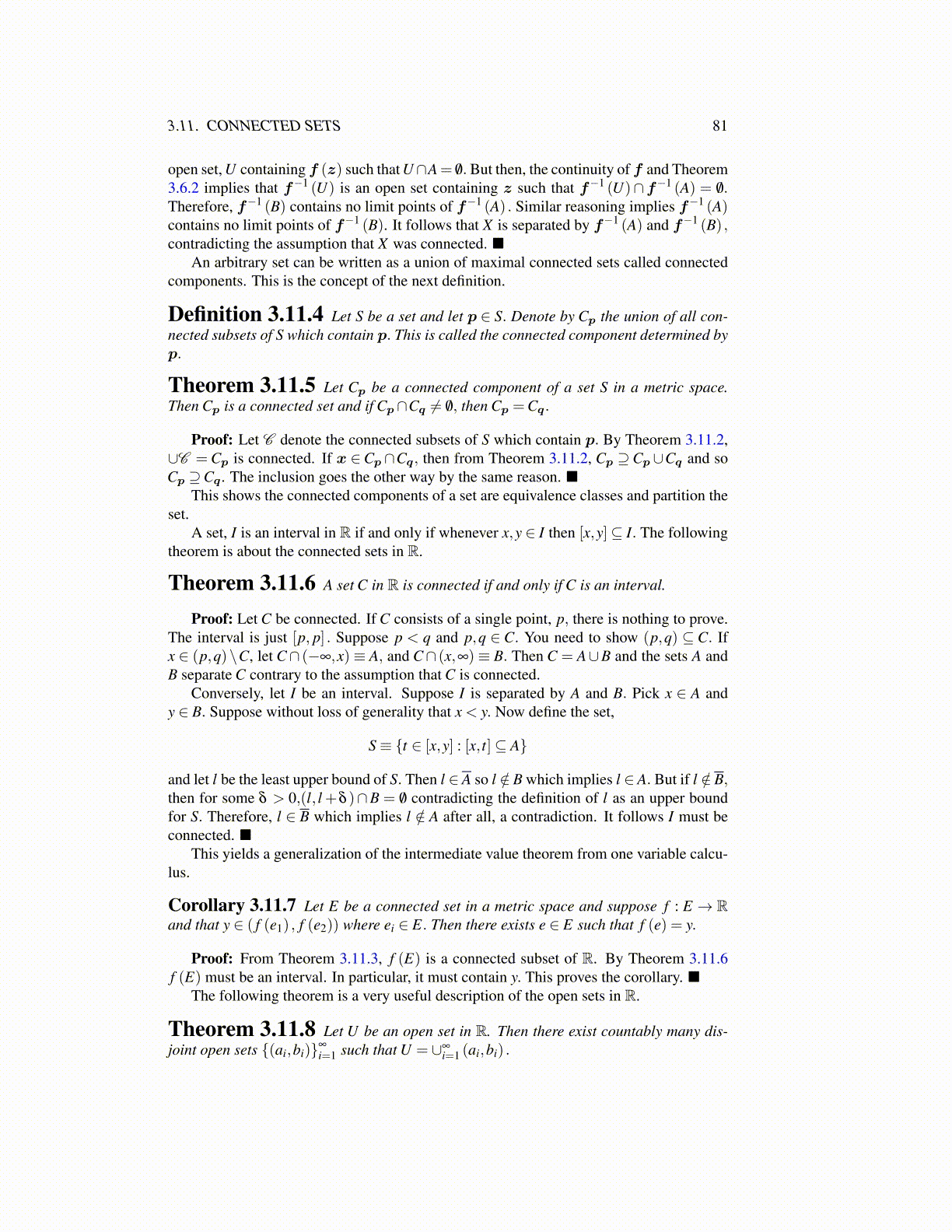
3.11. CONNECTED SETS 81
open set, U containing f (z) such that U∩A= /0. But then, the continuity of f and Theorem3.6.2 implies that f−1 (U) is an open set containing z such that f−1 (U)∩f−1 (A) = /0.Therefore, f−1 (B) contains no limit points of f−1 (A) . Similar reasoning implies f−1 (A)contains no limit points of f−1 (B). It follows that X is separated by f−1 (A) and f−1 (B) ,contradicting the assumption that X was connected. ■
An arbitrary set can be written as a union of maximal connected sets called connectedcomponents. This is the concept of the next definition.
Definition 3.11.4 Let S be a set and let p ∈ S. Denote by Cp the union of all con-nected subsets of S which contain p. This is called the connected component determined byp.
Theorem 3.11.5 Let Cp be a connected component of a set S in a metric space.Then Cp is a connected set and if Cp∩Cq ̸= /0, then Cp =Cq.
Proof: Let C denote the connected subsets of S which contain p. By Theorem 3.11.2,∪C = Cp is connected. If x ∈Cp ∩Cq, then from Theorem 3.11.2, Cp ⊇Cp ∪Cq and soCp ⊇Cq . The inclusion goes the other way by the same reason. ■
This shows the connected components of a set are equivalence classes and partition theset.
A set, I is an interval in R if and only if whenever x,y ∈ I then [x,y]⊆ I. The followingtheorem is about the connected sets in R.
Theorem 3.11.6 A set C in R is connected if and only if C is an interval.
Proof: Let C be connected. If C consists of a single point, p, there is nothing to prove.The interval is just [p, p] . Suppose p < q and p,q ∈ C. You need to show (p,q) ⊆ C. Ifx ∈ (p,q)\C, let C∩ (−∞,x)≡ A, and C∩ (x,∞)≡ B. Then C = A∪B and the sets A andB separate C contrary to the assumption that C is connected.
Conversely, let I be an interval. Suppose I is separated by A and B. Pick x ∈ A andy ∈ B. Suppose without loss of generality that x < y. Now define the set,
S≡ {t ∈ [x,y] : [x, t]⊆ A}
and let l be the least upper bound of S. Then l ∈ A so l /∈ B which implies l ∈ A. But if l /∈ B,then for some δ > 0,(l, l +δ )∩B = /0 contradicting the definition of l as an upper boundfor S. Therefore, l ∈ B which implies l /∈ A after all, a contradiction. It follows I must beconnected. ■
This yields a generalization of the intermediate value theorem from one variable calcu-lus.
Corollary 3.11.7 Let E be a connected set in a metric space and suppose f : E → Rand that y ∈ ( f (e1) , f (e2)) where ei ∈ E. Then there exists e ∈ E such that f (e) = y.
Proof: From Theorem 3.11.3, f (E) is a connected subset of R. By Theorem 3.11.6f (E) must be an interval. In particular, it must contain y. This proves the corollary. ■
The following theorem is a very useful description of the open sets in R.
Theorem 3.11.8 Let U be an open set in R. Then there exist countably many dis-joint open sets {(ai,bi)}∞
i=1 such that U = ∪∞i=1 (ai,bi) .